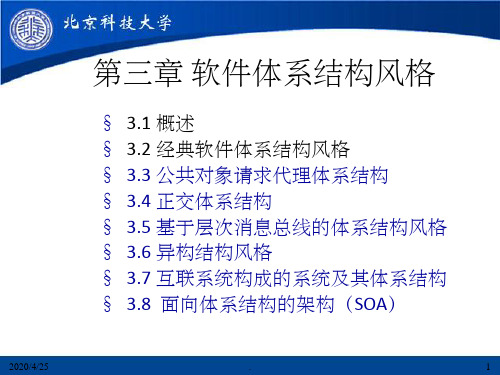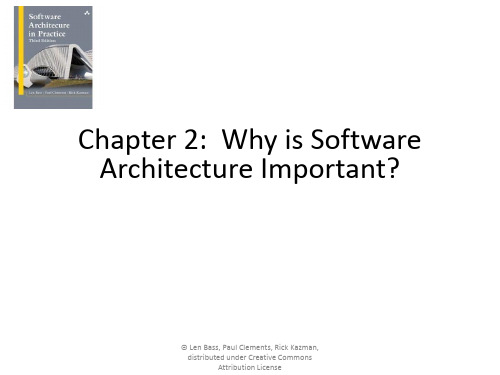- 1、下载文档前请自行甄别文档内容的完整性,平台不提供额外的编辑、内容补充、找答案等附加服务。
- 2、"仅部分预览"的文档,不可在线预览部分如存在完整性等问题,可反馈申请退款(可完整预览的文档不适用该条件!)。
- 3、如文档侵犯您的权益,请联系客服反馈,我们会尽快为您处理(人工客服工作时间:9:00-18:30)。
– Standard industry practices – Software engineering techniques prevalent in the architect’s professional community.
• Today’s information systems are web-based, objectoriented, service-oriented, mobility-aware, cloudbased, social-networking-friendly.
– “Why do you want this system to have a really fast response time?” – This differentiate the produeveloping organization capture market share.
– Technical. What technical role does the software architecture play in the system or systems of which it’s a part? – Project life cycle. How does a software architecture relate to the other phases of a software development life cycle? – Business. How does the presence of a software architecture affect an organization’s business environment? – Professional. What is the role of a software architect in an organization or a development project?
© Len Bass, Paul Clements, Rick Kazman, distributed under Creative Commons Attribution License
Architecture and Business Goals
• Systems are created to satisfy the business goals of one or more organizations.
© Len Bass, Paul Clements, Rick Kazman, distributed under Creative Commons Attribution License
Technical Context
• The most important technical context factor is the set of quality attributes that the architecture can help to achieve. • The architecture’s current technical environment is also an important factor.
• • • • • • • • Architecture in a Technical Context Architecture in a Project Life-Cycle Context Architecture in a Business Context Architecture in a Professional Context Stakeholders How Is Architecture Influenced? What Do Architectures Influence? Summary
Chapter 3: The Many Contexts of Software Architecture
© Len Bass, Paul Clements, Rick Kazman, distributed under Creative Commons Attribution License
Chapter Outline
• Some business goals will not show up in the form of requirements. • Still other business goals have no effect on the architecture whatsoever.
– A business goal to lower costs might be realized by asking employees to work from home, or turn the office thermostats down in the winter, or using less paper in the printers.
• Architects need to understand who the vested organizations are and what their goals are. Many of these goals will have a profound influence on the architecture.
© Len Bass, Paul Clements, Rick Kazman, distributed under Creative Commons Attribution License
Business Context
• Architectures and systems are not constructed frivolously. • They serve some business purposes. • These purposes may change over time.
– It wasn’t always so. – It won’t be so ten years from now.
© Len Bass, Paul Clements, Rick Kazman, distributed under Creative Commons Attribution License
Architecture Activities
• All of these processes include design among their obligations. • Architecture is a special kind of design, so architecture finds a home in each one. • No matter the software development process, there are activities involved in creating a software architecture, using that architecture to realize a complete design, and then implementing or managing the evolution of a target system or application:
– – – – – – – 1. Making a business case for the system 2. Understanding the architecturally significant requirements 3. Creating or selecting the architecture 4. Documenting and communicating the architecture 5. Analyzing or evaluating the architecture 6. Implementing and testing the system based on the architecture 7. Ensuring that the implementation conforms to the architecture
© Len Bass, Paul Clements, Rick Kazman, distributed under Creative Commons Attribution License
Architecture and Business Goals
• Every quality attribute—such as a user-visible response time or platform flexibility or ironclad security or any of a dozen other needs—should originate from some higher purpose that can be described in terms of added value.
© Len Bass, Paul Clements, Rick Kazman, distributed under Creative Commons Attribution License
Contexts of Software Architecture
• Sometimes we consider software architecture the center of the universe! • Here, though, we put it in its place relative to four contexts:
– – – – Waterfall Iterative Agile Model-driven development
© Len Bass, Paul Clements, Rick Kazman, distributed under Creative Commons Attribution License
Project Life-cycle Context





